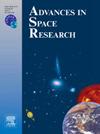为两颗带有合成孔径雷达有效载荷的 BDS-3 MEO 卫星(C45 和 C46)建立太阳辐射压力模型并进行比较
IF 2.8
3区 地球科学
Q2 ASTRONOMY & ASTROPHYSICS
引用次数: 0
摘要
经验性扩展 CODE 轨道模型,包括 5 参数缩减 ECOM(ECOM1)和 7 参数扩展 ECOM 模型(ECOM2),被广泛用于 BDS-3 MEO 卫星的太阳辐射压力(SRP)建模。这项研究表明,利用 ECOM 模型确定的 BDS-3 C45 和 C46 卫星轨道的卫星激光测距(SLR)残差显示出与-角或-角有关的系统依赖性。这两颗卫星的特点是卫星主体被拉伸,并多了一个搜索和救援(SAR)天线,这也是造成观测到的系统性变化的原因。在本研究中,基于可调箱翼和傅立叶变换以增强 ECOMa(ECOM + 沿轨加速度),建立了 C45 和 C46 卫星的先验 SRP 模型,并与 ECOM2 进行了比较。利用这些模型,确定了 2023 年 C45 和 C46 的精确轨道。SLR验证表明,取决于-角或-角的系统误差有所减少。一般来说,SLR 残差的标准偏差(STD)优于 3 厘米,与 ECOM2 模型相比提高了 2-3 倍。本文章由计算机程序翻译,如有差异,请以英文原文为准。
Modeling and comparison of solar radiation pressure for two BDS-3 MEO satellites (C45 and C46) with SAR payload
The empirical Extended CODE orbit model, including the 5-parameter reduced ECOM (ECOM1) and the 7-parameter extended ECOM model (ECOM2), is extensively utilized for solar radiation pressure (SRP) modeling of BDS-3 MEO satellites. This study shows that Satellite Laser Ranging (SLR) residuals of BDS-3 C45 and C46 satellite orbit determined with the ECOM model display a systematic dependency with respect to -angles or -angles. These two satellites are characterized by a stretched satellite body and an extra Search and Rescue (SAR) antenna, contributing to the observed systematic variations. In this study, the a priori SRP models for C45 and C46 satellites were established based on the adjustable box-wing as well as Fourier transformation to enhance the ECOMa (ECOM1 + along-track acceleration), and the comparison with ECOM2 was also presented. With these models, precise C45 and C46 orbits in 2023 were determined. SLR validation indicated a reduction in the systematic error dependent on -angles or -angles. In general, a standard deviation (STD) of SLR residuals better than 3 cm was achieved, reflecting an improvement of 2–3 times compared to the ECOM2 model.
求助全文
通过发布文献求助,成功后即可免费获取论文全文。
去求助
来源期刊

Advances in Space Research
地学天文-地球科学综合
CiteScore
5.20
自引率
11.50%
发文量
800
审稿时长
5.8 months
期刊介绍:
The COSPAR publication Advances in Space Research (ASR) is an open journal covering all areas of space research including: space studies of the Earth''s surface, meteorology, climate, the Earth-Moon system, planets and small bodies of the solar system, upper atmospheres, ionospheres and magnetospheres of the Earth and planets including reference atmospheres, space plasmas in the solar system, astrophysics from space, materials sciences in space, fundamental physics in space, space debris, space weather, Earth observations of space phenomena, etc.
NB: Please note that manuscripts related to life sciences as related to space are no more accepted for submission to Advances in Space Research. Such manuscripts should now be submitted to the new COSPAR Journal Life Sciences in Space Research (LSSR).
All submissions are reviewed by two scientists in the field. COSPAR is an interdisciplinary scientific organization concerned with the progress of space research on an international scale. Operating under the rules of ICSU, COSPAR ignores political considerations and considers all questions solely from the scientific viewpoint.
 求助内容:
求助内容: 应助结果提醒方式:
应助结果提醒方式:


